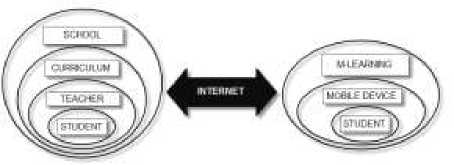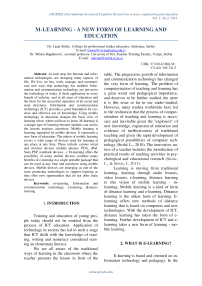M-learning - a new form of learning and education
Автор: Lazar Stošić, Milena Bogdanović
Журнал: International Journal of Cognitive Research in Science, Engineering and Education @ijcrsee
Рубрика: Studies and articles
Статья в выпуске: 2 vol.1, 2013 года.
Бесплатный доступ
At each step, the Internet and information technologies are changing many aspects of life. We live; we buy, work, manage, and communicate new ways that technology has enabled. Information and communication technology are pervasive the technology of today. It finds application in every branch of industry, and in all areas of education and the basis for the successful operation of all social and state structures. Information and communication technology (ICT) provides a good foundation for creative and effective use of knowledge. Using mobile technology in education changes the basic view of learning when, where and how to learn. M-learning is a unique type of learning because students can access the lessons anytime, anywhere. Mobile learning is learning supported by mobile devices. It represents a new form of education. The notion of mobile learning covers a wide range of devices used for learning at any place at any time. These include various wired and wireless devices (mobile phones, PDA, iPod, Sony PSP, notebook devices...). M-learning offers the possibility of using mobile devices combine many benefits of e-learning in a single portable package that can be used at any time and anywhere using mobile devices. Mobile devices are emerging as one of the most promising technologies to support learning as they offer new opportunities that do not offer static devices.
M-learning, information and communication technology, e-learning, distancelearning
Короткий адрес: https://sciup.org/170198379
IDR: 170198379 | УДК: 37.018.43:004.38
Текст научной статьи M-learning - a new form of learning and education
Training and education of young people today should not be omitted from the process of ICT education. Application of technology in society has led to such a stage that ICT skills with the knowledge of reading, writing and numeracy considered starting an elementary literacy.
We are all aware of the traditional ways of learning in the classroom where the teacher presents the lesson in front of the
UDK: 37.018.43:004.38 ;
371:621.395.721.5
table. The progressive growth of information and communication technology has changed the very form of learning. The problem of computerization of teaching and learning has a great social and pedagogical importance, and deserves to be further studied, the more it is this issue so far in our under-studied. However, many studies worldwide have led to the realization that the process of computerization of teaching and learning is necessary and inevitable given the ''explosion'' of new knowledge, expansion of education and evidence of ineffectiveness of traditional teaching and given the rapid development of pedagogical possibilities of computer technology (Stošić L., 2010) . The innovative nature of a teacher includes the introduction of practical results of teaching activities in psychological and educational research (Stosic, L., & Stosic, I., 2013).
Learning is moving from traditional learning, learning through audio lessons, video lessons, e-learning, distance learning to this vision of mobile learning - m-learning. Mobile learning is a kind of form of distance learning and e-learning. Distance learning is the oldest form of learning. Elearning offers new methods of distance learning that is based on computers and new technologies. With the development of ICT, distance learning has taken the form of elearning. Further development of ICT and elearning takes a new form of learning - mobile learning.
2. WHAT IS E-LEARNING?
E-learning is based and oriented on information technology and pedagogy. In the area of e-learning as the transfer of knowledge and skills over the Internet have growing impact web technology intelligence. Of concern to the application of web intelligence information systems on the web, ontological engineering, semantic web, interaction between people and computers and computer media, information management on the web, search and discover information and knowledge on the web, web agents, autonomous systems Agents, web mining and others. (Wintel, 2005-2007).
In the e-learning we have four different disciplines:
1. Distance education (courses as a collection of files associated with a number of hyperlinks of multimedia elements, reigning world the concept of distance learning involves the use of text materials, video conferencing and multimedia presentations),
2. Education at the right time (occasionally sends employees to training in certain disciplines),
3. Education using the Internet (using resources that are found on the Internet) and
4. Lifelong learning (concept of "lifelong student" who is always changing and improving the job).
3. THE BEGINNINGS OF M-LEARNING
Unlike traditional learning, which is mainly based on questions and answers, elearning is a set of the following processes: data collection, creation stories (research), creations (structuring of knowledge), interaction (communication with other students and experts in the wider community), setting questions and answers provide a virtual teacher. E-learning is project-oriented, allowing continuous access to new knowledge and continuous improvement. Online education is activated to a greater degree of creative potential of teachers and students, alleviate or eliminate their geographical isolation, to offer greater object of study and, not least, saving time and money. Weak side of e-learning, on the one hand, represent problems with the filtration of information, rapid obsolescence and changing the content, quality control and evaluation of resources, on the other hand, e-learning requires increased engagement in teacher preparation courses and in mastering the technology and the web software, as well as higher levels of activity with students.
One of the essential elements of the infrastructure to implement the concept of elearning is a web site. They can be of different types, for example, simple or static created in HTML, flash web site with animated graphics pages, presentations in the form of web services with programmed component exchange and modification of information, the dynamic database, a commercial realtime to handle different payments or business in which the handle and synchronize different business processes and the like. According to the second division there are three types of web sites. The first type consists of an integrated presentation consisting of the basic, dynamic forms and modules (forums, sections, links, files and photo album), mail server, web-mail services, and other statistics. The second type consists of a standard presentation, which consist of the basic, dynamic forms (surveys, contact forms, files, links, forums), and other statistics. The third type is a portal web site. Portal is a modern information system for setting and controlling the content of dynamic character. The main control system and administration is performed by an administrator. It contains the basic side, dynamic elements, web-mail, the panel's report, the administrative menu, contact form, multi-menu system, and automated photo album, a system for the news section for the files and links, the associated dynamical systems (e.g. private messages, section to represent users, the survey system to check the polls) (Bog-danović , M., 2009).
The concept of m-Learning, as well as the first type of learning with mobile devices, first appears in 1970s and 1980s. In those years, Alan Key and his colleagues proposed to make a mini computer that would replace the book. Name that computer was the Dynabook. First, a serious form of this type of learning occurs during the 1990s. Then the company Palm offered various discounts to educational institutions and companies that are using mobile learning in the PalmOS platform. It was not until the early 21st century, the European Commission began to support projects related to m-learning and multicountry project called MOBIlearn.
A. Characteristics of m-learning
One of the leading companies in the m-learning Mobile Learning Network Mo-LeNET. According to their definition of mobile learning involves connecting via download and installation of materials and work over a wireless network or mobile phone, and connect with the systems in institutions (Virtual learning environment - eng. Virtual Learning Environment - VLE). According to them, m-learning has the same great importance and in education, and in commercial environments. Because of easier portability m-learning allows for greater advantage of e-learning's (Picture 1).

Picture 1: M-learning environment
The three main components of m-learning are the following:
-
• The functionality of the hardware,
-
• The functionality of the software and
-
• Connections.
availability depends on their prices. The advantage of mobile devices is that they almost anyone can connect to the global network called the Internet world.
Today several communications technologies provide services to mobile devices. Some of them are:
-
• Global System for Mobile Communications (GSM)
-
• Wireless Application Protocol (WAP)
-
• General Packet Radio Service (GPRS)
-
• Bluetooth
-
• IEEE 802.11
-
• Infrared Data Association (IrDA).
The problems of mobile devices:
-
• Small PDAs and mobile phones have small screens and limited data display.
-
• Small keyboard PDAs and mobile phones make it difficult to enter data.
-
• Mobile devices have a memory.
-
• It is necessary from time to time to change that buy a new battery.
-
• It is not always possible for an application that is equipped for computer use on a mobile device.
-
• It is very difficult to keep track of videos on small devices.
-
• Price-to-use wireless communications is low.
The most common mobile devices used for mobile learning are:
• Mobile phones
• IPod
• Tablet RS
• Personal Digital Assistant (PDA)
• Smart phones
4. THE DIFFERENCES BETWEEN THE M-LEARNING AND E-LEARNING
C. Mobile phones
B. Devices for mobile learning
Mobile learning is inconceivable without the use of mobile devices. Bid and purchase of mobile devices is high and the
M-learning offers a unique opportunity for both teachers and students. The speakers will greatly shorten the time and effort in setting up and repeat the lessons, while students will be able at any time and as much as they want to repeat the lesson. While the elearning lessons must constantly monitor and respond to them, the m-learning is the exception. While e-learning requires learning from the classroom or rooms, m-learning is a new form that will break those limits. M-learning is particularly popular with younger generations who grew up using these mobile devices.
Benefits provided by the mobile learning e-learning:
• Can be used anywhere at any time;
• Many mobile devices are much cheaper than computers;
• Mobile devices are much smaller in size and are lightweight, allowing them to be worn by themselves at all times;
• Many students rely on the services of mobile learning...
5. CONCLUSION
Learning is a continuous process and does not end with school education. Daily training and education is inevitable (life-long learning, Chapter 12, Article 96 of the Law on Higher Education of the Republic of Serbia, 2005). Many successful companies organize constant training, training of staff, visits to trade fairs and seminars, and others. Employers in the market recognize diplomas and certificates at less obsolete programs. Some companies (e.g. Microsoft) make their certificates and licenses on an annual renewal of deposit or some other level; it is due to changes in technology and the emergence of new solutions that require competence in the market. It is necessary to constantly be learn- ing at this time cannot be imagined without the use of mobile devices that enable learning anytime and anywhere. M-learning is the future of e-learning. The new form of learning takes a new shape that is more accepted among younger generations grow up with mobile devices. M-learning can be characterized as a transition from distance learning, elearning to m-learning.


